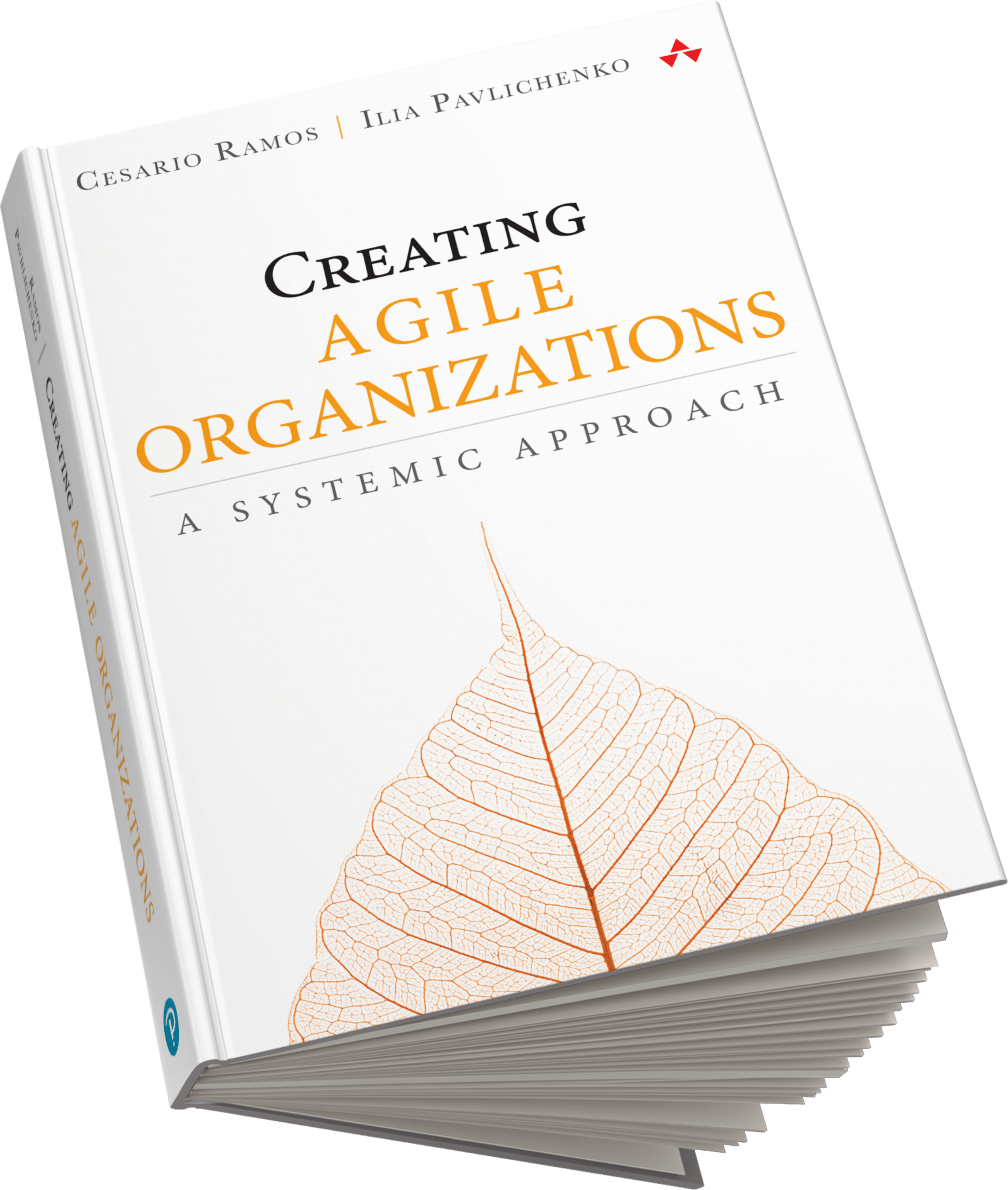Creating Agile Organizations
a systemic approach

Welcome to Creating Agile Organizations,
a book that explains how to guide a successful Agile transformation in your organization
a book that explains how to guide a successful Agile transformation in your organization
Welcome to Creating Agile Organizations,
a book that explains how to guide a successful Agile transformation in your organization
a book that explains how to guide a successful Agile transformation in your organization
Creating Agile Organizations helps Managers and Scrum Masters become effective change agents, and move from agility with individual teams to agility at large scale.
The book could be roughly divided into two parts. The first one, Foundational Concepts, includes Systems Thinking, basics of flow and resource efficiency, guidelines for organizational design, preferred coaching approach and guidelines for productive change. The second half of the book, Applying the Concepts, offers practical tools for large-scale organizational Agile adoption like, for example, defining a product workshop, tools for preparing and facilitating large scale Agile events, and guides for working with teams and leadership. The tools are explained using various real-life examples about organizations, Product Owners, and teams in their journey to become an Agile company.
The examples show how to prepare, structure, and guide large scale Agile adoptions. They provide real-life examples of organizational designs, challenges, solutions, and pitfalls to learn from. Finally, we share a few case studies of how Scrum is used to scale agility successfully on a large scale.


Part II
is about the problems that organizations face when adopting agility at scale. What are typical problems, organizational design flaws and what would need to change in order to be successful.
Chapter 1 — Organizing for Adaptability
Chapter 3 — Optimize for Adaptiveness
is about the strategic choice regarding optimization goals. It provides the basics of lean thinking and queueing theory to make informed tradeoffs between flow and resource efficiency.
Chapter 2 — Systems Thinking
describes the overarching approach to improve on organization. We introduce the basic concepts and techniques and lay the foundation for the rest of the book.
Chapter 4 — Agile Organization Design
describes organization design principles for use when working at the leadership level of an organization.
Chapter 5 — An Agile Adoption Approach
provides an overview of the adoption approach. We share a birds-eye view of the activities we found crucial for a large-scale adoption.
Chapter 6 — Coaching for Change
provides guiding principles on how to make the change successful
in your organization.
in your organization.
Chapter 7 — Group Facilitation
is about the many occasions where you need to facilitate a group of people. In this chapter, we share how to prepare, design, and facilitate workshops.
Chapter 9 — Launching the Product Group
shows how to successfully launch the product group and prepare to work in the new organization design. We provide a set of activities and techniques you can consider in your launch.
Chapter 8 — Preparing the Product Group
describes how to do just enough preparation to successfully start your transformation. We explain how to align management around their objectives, identify what needs to change, define your product, and how to identify the organizational elements to form the product group.
Chapter 10 — Coaching Teams
is about working with teams in a large group. We delve into what teams are and what you as a coach can do to guide team development. We discuss techniques you can use for coaching, and productive team relationships.
Chapter 11 — Guiding the Product Ownership
is about service to product ownership of a large product group. Who is the right person to lead the group? How to move away from output to outcome-based measures, and how to work with multiple teams.
Appendix — Case Studies and Workshop Examples
It is our hope that you, the reader of this book, will enjoy the benefits of Coaching Agile Organizations, and be inspired to face your organizational design challenges head-on.
Organizational Design is the most important factor that determines a level of Agility




Certified Agile Organization Trainer
Ilia Pavlichenko


Cesario Ramos
Certified Agile Organization Trainer
Authors
Ilia Pavlichenko
Ilia Pavlichenko leads Agile Transformations in companies around the world. He is an organization design consultant with rigorous focus on coaching senior management. Regularly speaks at international Agile / Scrum conferences. Ilia is also a Certified LeSS (Large-Scale Scrum) trainer, Professional Scrum Trainer (PST) from Scrum.org. In the past he was a programmer, project manager, Scrum Master and an Agile Coach at multiple product organizations. Ilia is a candidate for the Master of Sports in table tennis and streetlifting, fan of Queen and Brian May.


Cesario works worldwide as a senior management consultant on large-scale Agile adoptions in the financial and high tech industries. His international experience, a strong background in technology, and passion for people make him an influential partner in organisation design and in leading the adoption. Cesario has a MSc in mathematics and computing science from the University of Eindhoven and is also a Certified LeSS Trainer and Professional Scrum trainer from Scrum.org. Outside consultancy, Cesario served as a Java/C# developer, lead software architect, CTO
and as a product manager.
and as a product manager.
Cesario Ramos
co-creator of LeSS

Without other adaptive OD elements in place— such as teams not formally dedicated to one specialist domain — there might not be any concrete change.
Cesario and Ilia understand that. And they help us understand all that in this wonderful book from two passionate people with years in the trenches involved in large-scale adaptive development.
Cesario and Ilia understand that. And they help us understand all that in this wonderful book from two passionate people with years in the trenches involved in large-scale adaptive development.
Craig Larman

In this book, Cesario and Illia have provided a unique view of organizational agility. They firstly describe the foundational ideas that enable someone to approach the problem. The tools and vocabulary to think about agile enterprise-level change.
Dave West
CEO of Scrum.org

Creating agile organizations is hard work, requires patience, humour, and long-term commitment. It can take many years to simplify your organization and discover how to make agility work in your organization. But once you have been through all that, you ought to be able to react more effectively to changing market conditions
Certified Courses



